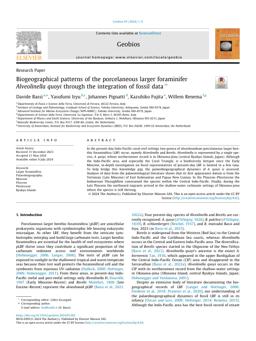2024-08-01
Biogeographical patterns of the porcelaneous larger foraminifer Alveolinella quoyi through the integration of fossil data
Publication
Publication
Geobios , Volume 85 p. 1- 9
In the present-day Indo-Pacific coral-reef settings two genera of alveolinoidean porcelaneous larger benthic foraminifera (LBF) occur, namely Alveolinella and Borelis. Alveolinella is represented by a single species, A. quoyi, whose northernmost record is in Okinawa-jima (central Ryukyu Islands, Japan). Although the Indo-Pacific area, and especially the Coral Triangle, is a biodiversity hotspot since the Early Miocene, in-depth investigation on fossil representatives of present-day LBF is limited to a few taxa. To help bridge this knowledge gap, the palaeobiogeographical dynamics of A. quoyi is assessed. Analysis of data from the palaeontological literature shows that its first appearance datum is from the Tortonian (Late Miocene) of East Kalimantan and Papua New Guinea. In the Pliocene–Pleistocene the Indonesian Throughflow constrained the species within the Central Indo-Pacific. Finally, during the Late Pliocene the northward migrants arrived in the shallow-water carbonate settings of Okinawa-jima where the species is still thriving.
| Additional Metadata | |
|---|---|
| doi.org/10.1016/j.geobios.2024.05.002 | |
| Geobios | |
| Released under the CC-BY 4.0 ("Attribution 4.0 International") License | |
| Organisation | Staff publications |
|
Bassi, Davide, Iryu, Yasufumi, Pignatti, Johannes, Fujita, Kazuhiko, & Renema, W. (2024). Biogeographical patterns of the porcelaneous larger foraminifer Alveolinella quoyi through the integration of fossil data. Geobios, 85, 1–9. doi:10.1016/j.geobios.2024.05.002 |
|
